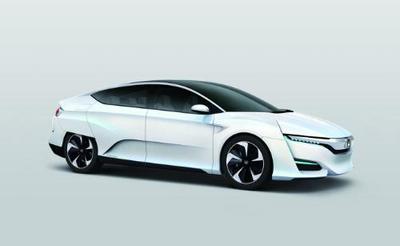Honda Supporting Growth of California Hydrogen Network with Financial Support to FirstElement Fuel
 |
Honda contribution of $13.8 million will further expand and accelerate the network of public hydrogen refueling stations
- Funding could enable FirstElement to add at least 12 stations to its California hydrogen network
TORRANCE, CA -- Nov. 19, 2014: Seeking to expand California's public hydrogen refueling station network as a means to support the wider introduction of fuel-cell vehicles, Honda will provide $13.8 million in financial assistance to FirstElement Fuel to build additional hydrogen refueling stations around the state. Additional state grants, combined with the Honda financing, could enable FirstElement to add at least 12 stations to its California hydrogen network.
"FirstElement Fuel is providing a vital piece of what is needed for a successful launch of fuel-cell vehicles," said Steven Center, vice president of Honda's Environmental Business Development Office. "Through this collaboration, FirstElement will enable our customers to experience hydrogen refueling that is as reliable, convenient and consumer-friendly as the vehicles are."
FirstElement received grants totaling nearly $27 million from the California Energy Commission earlier this year to build a network of 19 stations around the state. The state of California has a plan to invest $200 million into hydrogen station development over the next several years. This financial support from Honda, along with anticipated future grants from the State of California, will allow FirstElement to expand its network of stations by more than 50 percent, to at least 31 stations.
"This is an extremely positive step forward for the advancement of fuel-cell vehicles in the State of California," said Joel Ewanick, CEO of FirstElement Fuel. "We're so grateful for the confidence that Honda has shown in our team, and for Honda's leadership in the development and deployment of fuel-cell vehicles."
FirstElement Fuel is on its way to creating the world's first true retail hydrogen refueling network by developing and operating stations in California's metro areas, as well as in connector and destination locations. The company's goal is for drivers of fuel-cell vehicles to be able to travel seamlessly throughout the state, just as they are able to in a conventional gasoline vehicle today. As one of the leaders in the development of fuel cells, Honda has advocated for a robust and comprehensive network of hydrogen refueling stations to serve its customers.
Honda has led the industry for nearly two decades in the development and deployment of fuel-cell technology through extensive real world testing, including the first government fleet deployment and first retail customer lease programs in the United States. Honda has also made significant technological advancements in fuel cell operation in both hot and sub-freezing temperatures and in meeting safety regulations, since the introduction of its first generation fuel-cell vehicle, the FCX, in 2002. Honda launched its more recent fuel-cell vehicle, the FCX Clarity, in July 2008 as a real technological breakthrough in the areas of design, sedan packaging, assembly line manufacturing, and fuel-cell stack size and efficiency, winning the 2009 "World Green Car of the Year" award.
On November 17, 2014, the Honda FCV Concept was unveiled in Japan, pointing the way to an all-new Honda fuel-cell vehicles slated for launch first in Japan by March 2016 followed by launches in the U.S. and Europe. Honda's next-generation fuel-cell vehicle will feature a fuel-cell powertrain packaged completely in the engine room of the vehicle, allowing for efficiencies in cabin space as well as flexibility in the potential application of fuel-cell technology to multiple vehicle types in the future. The next-generation Honda FCV is anticipated to have a driving range of more than 300 miles.


